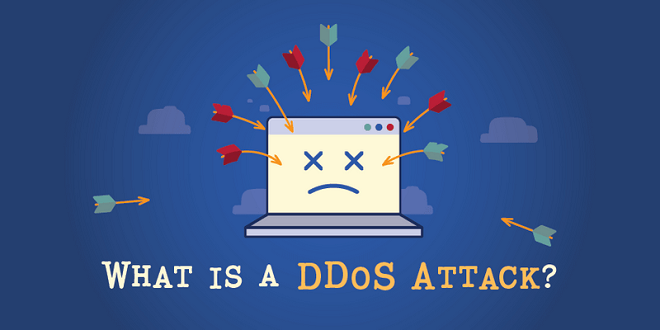We should begin by looking at precisely what a DDoS attack is and, critically, what it isn’t. DDoS represents Distributed Denial of Service yet is frequently pointed to as a basic denial of service. A DDoS attack comprises of a site being overflowed by requests during a brief timeframe, fully intent on overpowering the site and making it crash. The ‘distributed’ component implies that these attacks are coming from various areas simultaneously, when contrasted with a DoS which comes from only one area.
At the time when your site experiences a DDoS attack, you will get large number of requests from numerous sources over a time period consisting of minutes or maybe hours. These requests aren’t the aftereffect of a site abruptly getting a spike in web traffic: they are automated and will come from a set number of sources, depending upon the size of the attack.
A DDoS attack isn’t exactly the same thing as hacking, albeit the two can be connected; the culprits aren’t trying to get to your site’s records or files, yet all things being equal, they cause it to crash or become defenseless because of the volume of requests. Now and again, this will be trailed by attempts to hack the site when it’s defenseless; however in most of cases, the point is just to make the site quit working.
There may be times when it may seem that there isn’t any way of keeping away from a DDoS attack. All things considered, if somebody chooses to flood your site with requests, there isn’t a lot that you can do to stop them. However, in light of the fact that you don’t have much to do to stop somebody attempting to harm your site with a DDoS attack, there are steps you can take to guarantee that in case you are dependent upon an attack, your site will not stop working and it will not be defenseless against hacking.
We’ll cover those means later in this post, on the whole, how about we inspect why somebody should mount a DDoS attack on your site.
For what reason would somebody DDoS your site?
So for what reason would somebody mount a DDoS attack on your WordPress site? What could they need to acquire from it? There are many motivations behind why an aggressor should put your site down and out through a DDoS attack. These incorporate attacks by contenders and attacks on account of your content.
DDoS Attacks by Contenders
In an ideal world, your rivals would aim to beat you online by working on their content, Search engine optimization and conversion rate, which is the authentic way of utilizing your site to acquire an upper hand. In any case, sometimes, contenders may go to more outrageous lengths. A contender may employ somebody to mount a DDoS attack on your webpage in the light of the fact that this will not just affect your site, it’ll likewise affect your business.
In the time it takes you to get your site working once more, they will be taking business from you, particularly in case they are running promotions using your business name as a catchphrase. If your site isn’t ready for action again rapidly, you’ll lose search ranking and may track down that your rivals currently rank above you on Google.
Obviously, it’s undeniably challenging to demonstrate who carried out any DDoS attack. The attack will not come from your rival’s IP address! Except if you have exceptionally abundant resources, aiming to make a legitimate move against a contender you suspect of doing this is probably not going to be effective.
Your Content is vulnerable to DDoS attack
A few web sites are dependent upon DDoS attacks in view of the idea of their content. For instance, a whistleblowing site may be dependent upon an attack. A site managing a questionable issue (like admittance to fetus removal or anti-racist content) may experience the ill effects of individuals who can’t help contradicting its message and need to put it down and out. Or on the other hand your content may be business yet at the same time sensitive and there are individuals who don’t need it accessible on the web.
If your site is effectively attacked, it will put your content unavailable for general use, which could bring on some issues for your clients in the event that they need access to data or direction. You’ll likewise be investing energy settling the issue, losing any income you may be making from the site and your rankings can drop if your site is returning a 502 error for hours or days.
Politically Stimulated DDoS Attacks
Politically simulated DDoS attacks are turning out to be more common as cyber bullying is progressively used to upset the political process. If your site is for an political group, competitor or association, or advances a particular political reason, then, at that point, it could be defenseless against attack from individuals who can’t help contradicting your legislative issues.
This will not superfluously come from your political rivals. It is bound to come from outer sources that try to disturb political discussion, block particular sorts of content and use chaos to disturb and disappoint individuals. The attack could be an attempt to make it very difficult for individuals to get to your content or it very well may be a more personal attack on the singular candidate or association behind the site.
This is not quite the same as a site getting overloaded as a result of spikes in visits because of the consistent pattern of media reporting. All things considered, a DDoS attack will be a lot more honed and more unexpected, seeing an exceptionally abrupt spike in requests which may only last for a few minutes. This will appear to be exceptionally unique from a characteristic spike in traffic, which despite the fact that it tends to be unexpected will ordinarily appear as a curve rather than a mount or cliff.
Appsealing helps you with preventing DDoS attacks and other threats that may disturb your business in any manner.
 NEWSHUNTS
NEWSHUNTS




